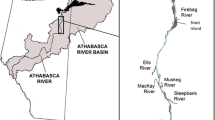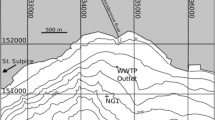Abstract
Purpose
The transport of fine sediments and associated chemical constituents originating from potential anthropogenic and natural sources is becoming an issue of increasing importance in the Lower Athabasca River (LAR) ecosystem in northern Alberta, Canada. This study aims to (1) establish an integrated numerical modelling framework to investigate the transport of fine cohesive sediments and associated chemical constituents during both ice-covered and open-water periods and (2) apply the modelling framework to investigate the state and temporal/spatial variation in sediment and selected chemical constituents within the LAR.
Materials and methods
One-dimensional hydrodynamic and transport models, combined with a river ice model, are used to predict the flow characteristics, transport of sediments and a selection of three metals and three polycyclic aromatic hydrocarbons (PAHs) within a ∼200 km reach of the LAR, both in open-water and ice-covered conditions. The models are validated using available field measurements and are applied to investigate the state and variation of sediment and chemicals for a baseline period as well as to assess the effect of various hypothetical pollution scenarios.
Results and discussion
The model simulations successfully reproduce the hydrodynamics and sediment transport patterns as well as the state and variation of selected metal and PAH constituents. The results generally show that the concentration of chemical constituents in the bed sediment is the major factor in determining the state and variation of their concentration in the water column, and the high-flow season is the critical period for the transport of sediment and chemicals in the system. The scenario simulation results indicate that increases in the concentrations of chemical constituents in tributary streams have to be orders of magnitude higher to have a noticeable effect on their corresponding water column concentration in the LAR. Those effects are also found to be higher only within the immediate vicinity of the tributary confluences and gradually diminish with distance downstream of the confluences.
Conclusions
The numerical modelling framework developed in this study provides a tool for investigation and understanding of the state and temporal/spatial variation of sediment and associated chemical constituents within cold region rivers such as the LAR. By conducting additional scenario-based studies (such as future climate and chemicals loading), the models can be used to identify possible future states of sediment and water quality constituents in the LAR ecosystem.















Similar content being viewed by others
References
Akre CJ, Headley JV, Conly FM, Peru KM, Dickson LC (2004) Spatial patterns of natural polycyclic aromatic hydrocarbons in sediment in the lower Athabasca River. J Environ Sci Heal A 39(5):1163–1176
Andrishak R, Abarca JN, Wojtowicz A, Hicks F (2008) Freeze-up study on the Lower Athabasca River (Alberta, Canada). Proc. 19th IAHR Ice Symposium. Vancouver, Canada 1:77–88
Canada-Alberta Joint Oil-Sands Monitoring Program (2012)
Canada-Alberta Joint Oil Sands Monitoring Portal (JOSMP) (2015) http://www.jointoilsandsmonitoring.ca. Accessed 10 Oct 2015
Canadian Council of Ministers of the Environment (CEMA) (2012) Lower Athabasca data. http://ftp.cciw.ca/incoming/LowerAthabasca_data_March05.12/. Accessed 10 Nov 2012
Conly FM, Crosley RW, Headley JV (2002) Characterizing sediment sources and natural hydrocarbon inputs in the lower Athabasca River, Canada. J Environ Eng Sci 1(3):187–199
Conly FM, Crosley RW, Headley JV, Quagraine EK (2007) Assessment of metals in bed and suspended sediments in tributaries of the Lower Athabasca River. J Environ Sci Health 42(8):1021–1028
Danish Hydraulics Institute (DHI) (2012) MIKE11 user guide & reference manual. Danish Hydraulics Institute, Horsholm
Droppo IG, Krishnappan BG (2014) Cohesive sediment transport—part I: a modelling approach. Under Environment Canada Internal Review
Droppo IG, D’Andrea L, Krishnappan BG, Jaskot C, Trapp B, Basuvaraj M, Liss SN (2014) Fine-sediment dynamics: towards an improved understanding of sediment erosion and transport. J Soils Sediments 15(2):467–479
Environment Canada (EC) Climate Database (2013) http://climate.weather.gc.ca. Accessed 10 Sept 2013
Ettema R, Daly SF (2004) Sediment transport under ice. ERDC/CRREL TR-04-20. Cold Regions Research and Engineering Laboratory, US Army Corps of Engineers
Eum HI, Dibike YB, Prowse TD (2014) Uncertainty in modelling the hydrologic responses of a large watershed: a case study of the Athabasca River Basin, Canada. Hydrol Process 28(14):4272–4293
Garcia-Aragon J, Droppo IG, Krishnappan B, Trapp B, Jaskot C (2011) Experimental assessment of Athabasca River cohesive sediment deposition dynamics. Wat Qual Res J Can 46(1):87–96
Geobase (2012) http://www.geobase.ca/geobase/en/index.html. Accessed Oct 2012
Ghosh U, Gillette JS, Luthy RG, Zare RN (2000) Microscale location, characterization, and association of polycyclic aromatic hydrocarbons on harbour sediment particles. Environ Sci Technol 34:1729–1736
Hall RI, Wolfe BB, Wiklund JA, Edwards TW, Farwell AJ, Dixon DG (2012) Has Alberta Oil-Sands development altered delivery of polycyclic aromatic compounds to the Peace-Athabasca Delta? PLoS One 7(9):e46089
Headley JV, Akre C, Conly FM, Peru KM, Dickson LC (2001) Preliminary characterization and source assessment of PAHs in tributary sediments of the Athabasca River, Canada. Environ Forensic 2(4):335–345
Hicks F (2011) Personal Communication (2011)
Kashyap S, Oveisy A, Shakibaeinia A, Dibike YB, Prowse TD, Droppo IG (2014) Numerical modeling of flow and sediment transport within the lower reaches of the Athabasca River: a case study. Proc. HIC 2014, 11th International Conference on Hydroinformatics, New York, USA
Kelly EN, Schindler DW, Hodson PV, Short JW, Radmanovich R, Nielsen CC (2010) Oil-sands development contributes elements toxic at low concentrations to the Athabasca River and its tributaries. Proc Natl Acad Sci 107(37):16178–16183
Khanna VK, Herrera WV (2003) Comparison of the one-D and cdg1-D models in the lower Athabasca River basin to estimate high flows during open-water season. Environment Canada Report
Knack I, Shen HT (2015) Sediment transport in ice-covered channels. Int J Sediment Res 30(1):63–67
Pietroniro A, Hicks F, Andrishak A, Watson D, Boudreau P, Kouwen N (2011) Hydraulic routing of flows for the Mackenzie River, Environment Canada, University of Alberta & National Research Council of Canada
Prowse TD (2001) River-ice ecology. I: hydrologic, geomorphic, and water-quality aspects. J Cold Reg Eng 15(1):1–16
Regional Aquatics Monitoring Program (RAMP) (2013) Monitoring database: sediment quality. http://www.ramp-alberta.org/data/Sediment/sediment.aspx (Nov. 2013)
Shakibaeinia A, Kashyap S, Dibike YB, Prowse TD (2016) An integrated numerical framework for water quality modelling in cold-region rivers: a case of the lower Athabasca River. Sci Total Environ 569:634–646
Shen HT (2005) CRISSP1D programmer’s manual. Prepared by Department of Civil Engineering, Clarkson University, Potsdam, NY for CEA Technologies Inc. (CEATI). CEATI Report No. T012700-0401
Timoney KP, Lee P (2009) Does the Alberta tar sands industry pollute? The scientific evidence. Open Conserv Biol J 3:65–81
Van Rijn LC (1984) Sediment transport, part I: bed load transport. J Hydraul Eng 110(10):1431–1456
Water Survey of Canada (WSC) (2013) Hydat database. https://www.ec.gc.ca/rhc-wsc/default.asp?lang=En&n=9018B5EC-1. (July, 2013)
Wiklund JA, Hall RI, Wolfe BB, Edwards TW, Farwell AJ, Dixon DG (2014) Use of pre-industrial floodplain lake sediments to establish baseline river metal concentrations downstream of Alberta Oil-Sands: a new approach for detecting pollution of rivers. Environ Res Lett 9(12):124019
Wrona FJ, Carey J, Brownlee B, McCauley E (2000) Contaminant sources, distribution and fate in the Athabasca, Peace and Slave River Basins, Canada. J Aquat Ecosyst Stress Recover 8(1):39–51
Acknowledgements
The financial support for this study was provided by the Government of Alberta and Environment Canada Joint Oil-Sands Monitoring Program (JOSMP). The authors would like to thank Drs. Fred Wrona, Anil Gupta, Spyros Beltaos, Patricia Chambers and Malcolm Conly for their comments and support at the different stages of this project. The authors acknowledge Dr. Hyung-Il Eum for his help in providing the Athabasca River hydrological modelling data, Tom Carter and Jennifer Pesklevits for collecting and processing the GeoSwath data, Dr. Fay Hicks for providing some of the Lower Athabasca River cross-sectional data and Martin Jasek for his comments and helps with the CRISSP1D model. The authors would also like to thank Dr. Roderick Hazewinkel from Alberta Environment and Parks for facilitating access to the LiDAR data used in preparing the bathymetry for the Athabasca River and its flood plains.
Author information
Authors and Affiliations
Corresponding author
Additional information
Responsible editor: Kimberley N. Irvine
Electronic supplementary material
ESM 1
(DOCX 333 kb)
Rights and permissions
About this article
Cite this article
Shakibaeinia, A., Dibike, Y.B., Kashyap, S. et al. A numerical framework for modelling sediment and chemical constituents transport in the Lower Athabasca River. J Soils Sediments 17, 1140–1159 (2017). https://doi.org/10.1007/s11368-016-1601-4
Received:
Accepted:
Published:
Issue Date:
DOI: https://doi.org/10.1007/s11368-016-1601-4




